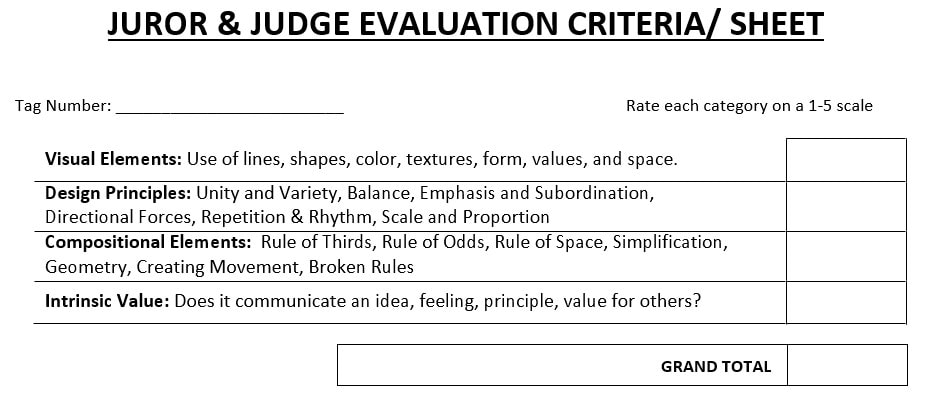LAA Guide for Evaluating and Judging Art in Competitions
| laa_art_analysis_and_evaluation_100722.pdf |
A standard protocol for analyzing and evaluating art will benefit all artists and facilitate consistency and fairness of competition. It will also advance the knowledge, understanding, and practice of the arts.
This document offers a “minimalist” guide to artists, judges, jurors, and organizers of various LAA competitions. It nurtures a common vocabulary and baseline for organizing, analyzing, and evaluating art submissions.
The LAA five-step approach:
1. DESCRIPTION: What You See (the observable facts). At this stage, you don’t have to analyze anything.
2. ANALYSIS: Mentally separate the parts or elements, thinking in terms of textures, shapes/forms, light/dark or bright/dull colors, types of lines. What are the most important principles of design used to organize the elements? What compositional elements were employed?
This document offers a “minimalist” guide to artists, judges, jurors, and organizers of various LAA competitions. It nurtures a common vocabulary and baseline for organizing, analyzing, and evaluating art submissions.
The LAA five-step approach:
- Description – What you see
- Analysis – Separate the parts
- Interpretation – What does it mean to you
- Judgment - Assessment
- Review – Shared understanding and learning
1. DESCRIPTION: What You See (the observable facts). At this stage, you don’t have to analyze anything.
- Look at the support, overall shape, scale, and medium
- Itemize the literal objects in the painting (trees, people, animals, mountains, rivers, etc.).
- What do you notice first when you look at the work?
- What kinds of colors do you see? What are the value relationships?
- What shapes can we see? What kind of edges do the shapes have?
- Are there lines in the work? If so, what kinds of lines are they?
- What sort of textures do you see?
- What is the overall visual effect or mood of the work?
2. ANALYSIS: Mentally separate the parts or elements, thinking in terms of textures, shapes/forms, light/dark or bright/dull colors, types of lines. What are the most important principles of design used to organize the elements? What compositional elements were employed?
Suggested questions to help with analysis:
3. INTERPRETATION: An interpretation seeks to explain the meaning of the work based on what you have learned so far about the artwork; what do you think the artist was trying to say?
4. JUDGMENT: After careful observation, analysis, and interpretation of an artwork, you are ready to make your judgment. Your evaluation is your understandings of the work. Questions you might consider:
- How have lines been used?
- How has the artist used shapes?
- How has the artist used light? Is there the illusion of a scene with lights & shadows, or does the artist use light and dark values in an abstract way?
- How has the artist used colors?
- What role does texture play?
- How has the overall visual effect or mood of the work been achieved?
3. INTERPRETATION: An interpretation seeks to explain the meaning of the work based on what you have learned so far about the artwork; what do you think the artist was trying to say?
- What was the artist’s statement in this work?
- What do you think it means?
- What does it mean to you?
- How does this relate to you and your life?
- What feelings do you have when looking at this artwork?
- Do you think there are things in the artwork that represent other things/symbols?
- Why do you think that the artist chose to work in this manner and made these artistic decisions?
- Why did the artist create this artwork?
4. JUDGMENT: After careful observation, analysis, and interpretation of an artwork, you are ready to make your judgment. Your evaluation is your understandings of the work. Questions you might consider:
- Why do you think this work has intrinsic value or worth? (For example, is it a beautiful work of art, does it convey an important social message, affects how I see the world, makes insightful connections, reaffirms a religious belief, etc.)
- Do you think that the work has a benefit for others?
- Do you find that the work communicates an idea, feeling, principle, or value for others?
- Could the reason you find the work lacking come from poor use of the elements of art?
- Is the subject matter unappealing, unimaginative, or repulsive? How?
- What kind of an effect do you think the work could have for others?
- Do you think that the work is just o.k.? What do you base this opinion? The use of elements of art? Lack of personal expression? Does the work lack a central focus?
5. REVIEW: Select the top two or three works to create a short list from each category. As this is done, collaboratively share your assessment to determine placement of submissions.
Note: LAA wishes to continually improve our competition process with best practices. Please offer feedback to the following committee members: Dusty Reed – Chair, Susan Chiqelin, Simone Palmer, Ed DeMahy, Margaret Melancon, Guy Kilchrist. Our intention is to review our processes annually and update as necessary.


